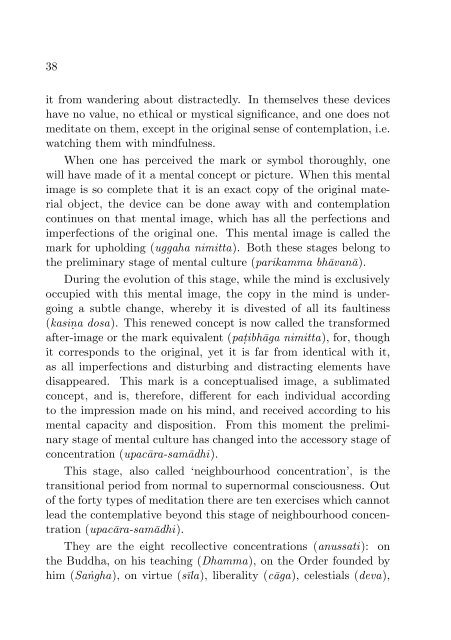Agony and Ecstasy
A comparative study of the five hindrances, together with the five states of concentration or mental absorption.
A comparative study of the five hindrances, together with the five states of concentration or mental absorption.
Create successful ePaper yourself
Turn your PDF publications into a flip-book with our unique Google optimized e-Paper software.
38<br />
it from w<strong>and</strong>ering about distractedly. In themselves these devices<br />
have no value, no ethical or mystical significance, <strong>and</strong> one does not<br />
meditate on them, except in the original sense of contemplation, i.e.<br />
watching them with mindfulness.<br />
When one has perceived the mark or symbol thoroughly, one<br />
will have made of it a mental concept or picture. When this mental<br />
image is so complete that it is an exact copy of the original material<br />
object, the device can be done away with <strong>and</strong> contemplation<br />
continues on that mental image, which has all the perfections <strong>and</strong><br />
imperfections of the original one. This mental image is called the<br />
mark for upholding (uggaha nimitta). Both these stages belong to<br />
the preliminary stage of mental culture (parikamma bhāvanā).<br />
During the evolution of this stage, while the mind is exclusively<br />
occupied with this mental image, the copy in the mind is undergoing<br />
a subtle change, whereby it is divested of all its faultiness<br />
(kasiṇa dosa). This renewed concept is now called the transformed<br />
after-image or the mark equivalent (paṭibhāga nimitta), for, though<br />
it corresponds to the original, yet it is far from identical with it,<br />
as all imperfections <strong>and</strong> disturbing <strong>and</strong> distracting elements have<br />
disappeared. This mark is a conceptualised image, a sublimated<br />
concept, <strong>and</strong> is, therefore, different for each individual according<br />
to the impression made on his mind, <strong>and</strong> received according to his<br />
mental capacity <strong>and</strong> disposition. From this moment the preliminary<br />
stage of mental culture has changed into the accessory stage of<br />
concentration (upacāra-samādhi).<br />
This stage, also called ‘neighbourhood concentration’, is the<br />
transitional period from normal to supernormal consciousness. Out<br />
of the forty types of meditation there are ten exercises which cannot<br />
lead the contemplative beyond this stage of neighbourhood concentration<br />
(upacāra-samādhi).<br />
They are the eight recollective concentrations (anussati): on<br />
the Buddha, on his teaching (Dhamma), on the Order founded by<br />
him (Saṅgha), on virtue (sīla), liberality (cāga), celestials (deva),

















